In a previous article on fxguide, one visual effects supervisor described his team as the ‘can-do’ department. That’s a fitting description for the artists at Mr. X Inc, who played a crucial role in director Paul W.S. Anderson’s Pompeii. Not only did they wreak havoc with destruction sims to destroy the famous city after a volcanic eruption, but their work for the film’s teaser trailer was so influential it made it into the final release. Plus, artists were then called upon to ensure a key pitch shot was reinstated in the film when its investors thought it had been forgotten.
Lava bit of destruction
First up, how did Mr. X create the city of Pompeii, its surrounding areas (including Mount Vesuvius) and then destroy it with a mix of lava bombs, a tidal wave and a massive pyroclastic flow? The answer lies in early and constant interaction with the director to plan out the destruction, previs it and then bring it to life via the company’s Toronto and New York studios (overseen by visual effects supervisor Dennis Berardi) as well as external vendors. Here’s the major toolsets Mr. X relied upon for their shots.
Destruction everywhere: Mr. X’s main software for rigid body sims was its proprietary version of Bullet in Houdini. From here the effects team would use Houdini Particles for secondary debris, and Houdini’s built-in Pyro solver for volumetric elements such as dust and smoke. The Pyro solver was also used for the massive pyroclastic flow and fire effects
Lava bombs: These were a mix of Houdini’s Pyro solver and Mr. X’s in-house FLIP-based smoke solver.
Water interaction: RealFlow was used to simulate a patch of hero water and then seamed that with a larger procedural surface. For wider shots, Mr. X used the Houdini OceanFX Ocean Spectrum and Ocean Evaluate tools to generate procedural ocean vector displacement maps. A custom displacement shader was used to apply the vector displacement along with additional small-scale noise patterns to prevent tiling. From there the team relied on RealFlow to simulate interactive foam particles which were then run through the same procedural displacements as the surface water to keep the foam on the surface.
Ship sails: The team relied on Houdini Cloth, with destruction of wood and splintering carried out using DMM within Houdini.
Trees: Here, Mr. X used SpeedTree to create foliage, and then ran destruction sims with DMM and Fast Point Instancing in Houdini to populate forests.
From teaser to the theater
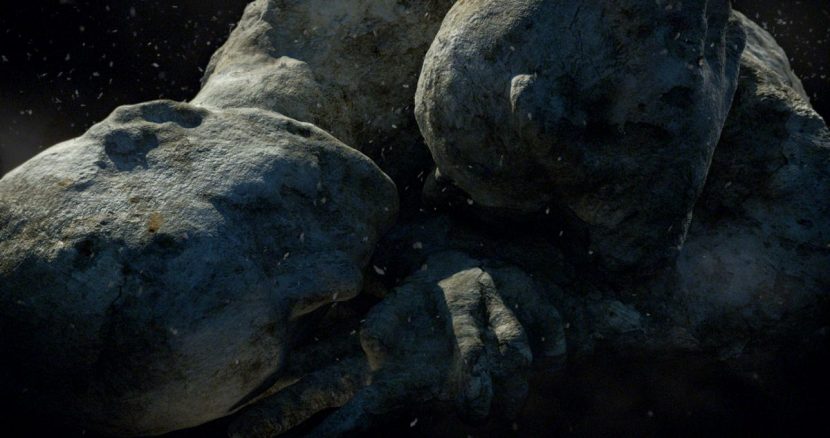 Midway through the production on Pompeii, the filmmakers had to produce a teaser trailer. They looked to Mr. X to create what would initially be a unique sequence of ‘micro-landscapes’ – CG renderings of dead citizens of the city in their final poses. What the studio produced for the teaser was so successful that it made its way into the final film.
Midway through the production on Pompeii, the filmmakers had to produce a teaser trailer. They looked to Mr. X to create what would initially be a unique sequence of ‘micro-landscapes’ – CG renderings of dead citizens of the city in their final poses. What the studio produced for the teaser was so successful that it made its way into the final film.
“When the excavated Pompeii they didn’t actually find remains,” explains Eric Robertson, visual effects supervisor and President of Mr. X’s Gotham outpost in New York. “They found a hole and they filled out the holes with plaster and that’s how they got the shapes of the bodies. They are very haunting poses.”
Mr. X Gotham was tasked with creating a 30 second sequence out of individual tight shots of these plaster bodies for the teaser. “We did some research and found some of the more moving poses,” says Robertson. “We looked for interesting scenes that almost told a story even though they were just statues.”
Artists sculpted these in MARI in high detail, since the camera would be only around 2 inches off their surface and move slowly along it. “Every time the camera moved it both panned and tilted and dollied across the surface,” says Robertson, “so there was a great sense of perspective change during the shot. That was even more spectacular given it was stereoscopic 3D.”
The initial models with some blocking were pitched to the director and then put into production for the teaser trailer. Artists had three weeks to turn the shots around. “We found some nice ways to procedurally model the detail in the surface texture itself and had a beautiful result,” describes Robertson. “We got into lighting in about three or four days. We did a test on one of the shots all the way through to confirm the stoney and lichen-looking texture which had a lot of depth and color.”
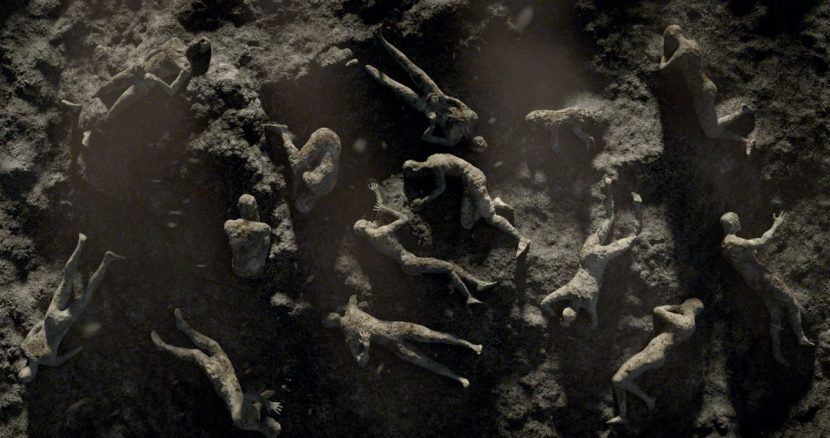 “Then we added in the environments which was a hazy smokey black nebulas background,” adds Robertson. “Then we added in an ash layer. The mandate was to treat the shots as if you’re flying over a mountain range.”
“Then we added in the environments which was a hazy smokey black nebulas background,” adds Robertson. “Then we added in an ash layer. The mandate was to treat the shots as if you’re flying over a mountain range.”
Ultimately, the images created for the teaser were extremely well-received. “Paul liked it so much that he decided to begin the film with those shots, modified slightly,” says Robertson, “but also to end the film with that final shot which is a wider shot. It was a nice way for us to contribute in a creative way to the overall project.”
‘Where’s the salmon shot?’
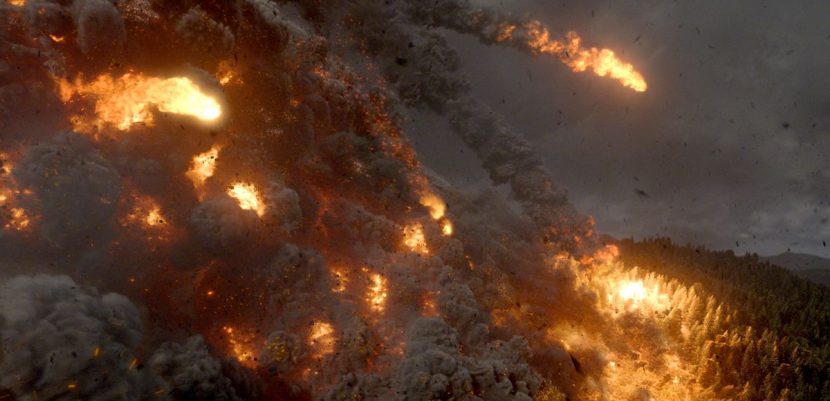 Sometimes the visual effects team are called upon to make special things happen. One such thing happened during the production of Pompeii, as recounted by visual effects producer Jo Hughes:
Sometimes the visual effects team are called upon to make special things happen. One such thing happened during the production of Pompeii, as recounted by visual effects producer Jo Hughes:
“When Paul was originally pitching the film to the German investors he mentioned to them a shot with Milo – the young hero gladiator who’s in love with Cassia – where he’s running back into Hell to save her. Paul described this shot of it being like salmon swimming upstream and everyone else is running away from this hellfire as Mt Vesuvius is erupting.
When the film came together, that shot just hadn’t made it into the edit, and one of the producers said, ‘Where is the salmon upstream shot?’
So part way through post production we made a version of this shot – we postvis’d it and added it into the edit. And then rather quickly we had to deal with the dynamics, the sims of the buildings being destroyed by lava bombs, plus rather large crowd sim of our keyframe Milo running against the crowd.”

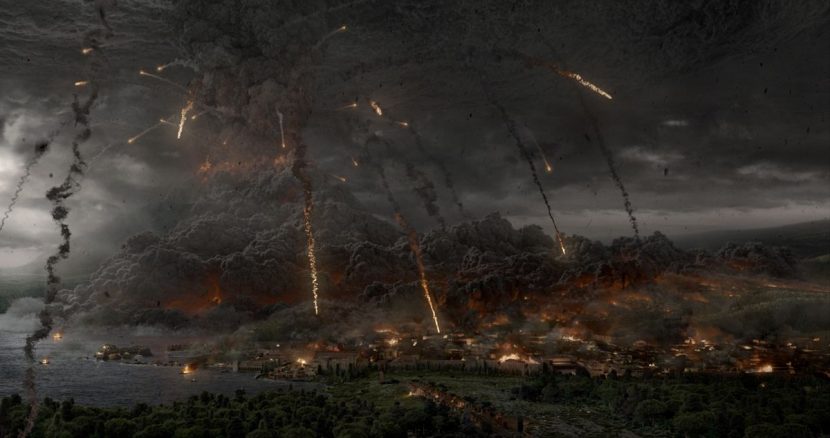
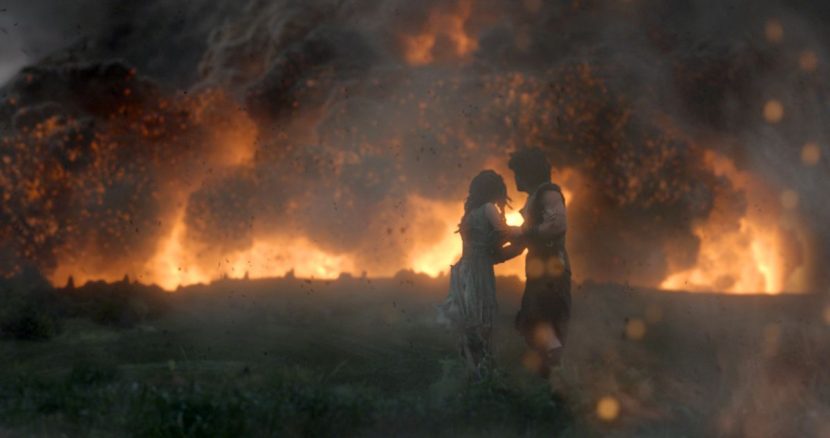
What about Scanline? I heard they did a lot of great work on this too.
Pingback: The VFX of Pompeii 3D : OD|FORCE
Pingback: Pompeii (2014) | Jonathan McCallum